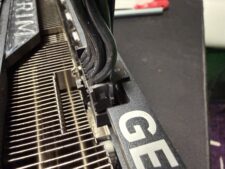Asus ROG Strix Scar 17 X3D Review: 3D V-Cache Comes to Laptops
AMD’s best CPUs for gaming, its X3D series using 3D V-cache, have been limited to gaming desktops. But that’s no longer the case. The Asus ROG Strix Scar 17 X3D ($3,599 as tested) is the first gaming laptop with a CPU using that technology: the AMD Ryzen 9 7945HX3D. Paired with Nvidia’s GeForce RTX 4090 for laptops, this system is prepared to reduce latency and push as many frames as possible.
In our testing, we found that this powerful chip at the center the Scar 17 rivals Intel’s best gaming laptops, and is an improvement over AMD’s existing flagship mobile processor, the Ryzen 9 7945HX.
But the system as a whole doesn’t scream flagship. The display is still yesteryear’s 16:9 aspect ratio (but at a respectable 1440p resolution), and there’s a 720p webcam. There’s also a question of if the performance is worth the extra cost. Because this laptop, like many flagships, is not cheap.
Design of the Asus ROG Strix Scar 17 X3D
While Asus has a special edition laptop with an exclusive, top-of-the-line AMD chip, the Scar 17 X3D doesn’t do anything to feel particularly special. It looks very much like many of Asus’ previous Scars, including the Intel-based Strix Scar 18 released earlier this year, as well as last year’s Strix Scar 17 SE.
So to gamers, this will be familiar. The lid bears a reflective ROG logo (which lights up around the edges when the system is on) and a diagonal stripe (featuring more of that logo, repeatedly), which is not exactly my favorite design decision. Otherwise, it’s a dark gray aluminum lid. While some recent Strix Scars have customizable plastic caps along the spine, this one’s end cap doesn’t come off; it’s just gray.
The 17.3-inch, 16:9 screen has thin enough bezels on three sides, but a very chunky one on the button. A small lip coming out of the top houses the 720p webcam. Notably, that lip doesn’t contain any other sensors, like infrared for facial recognition with Windows Hello.
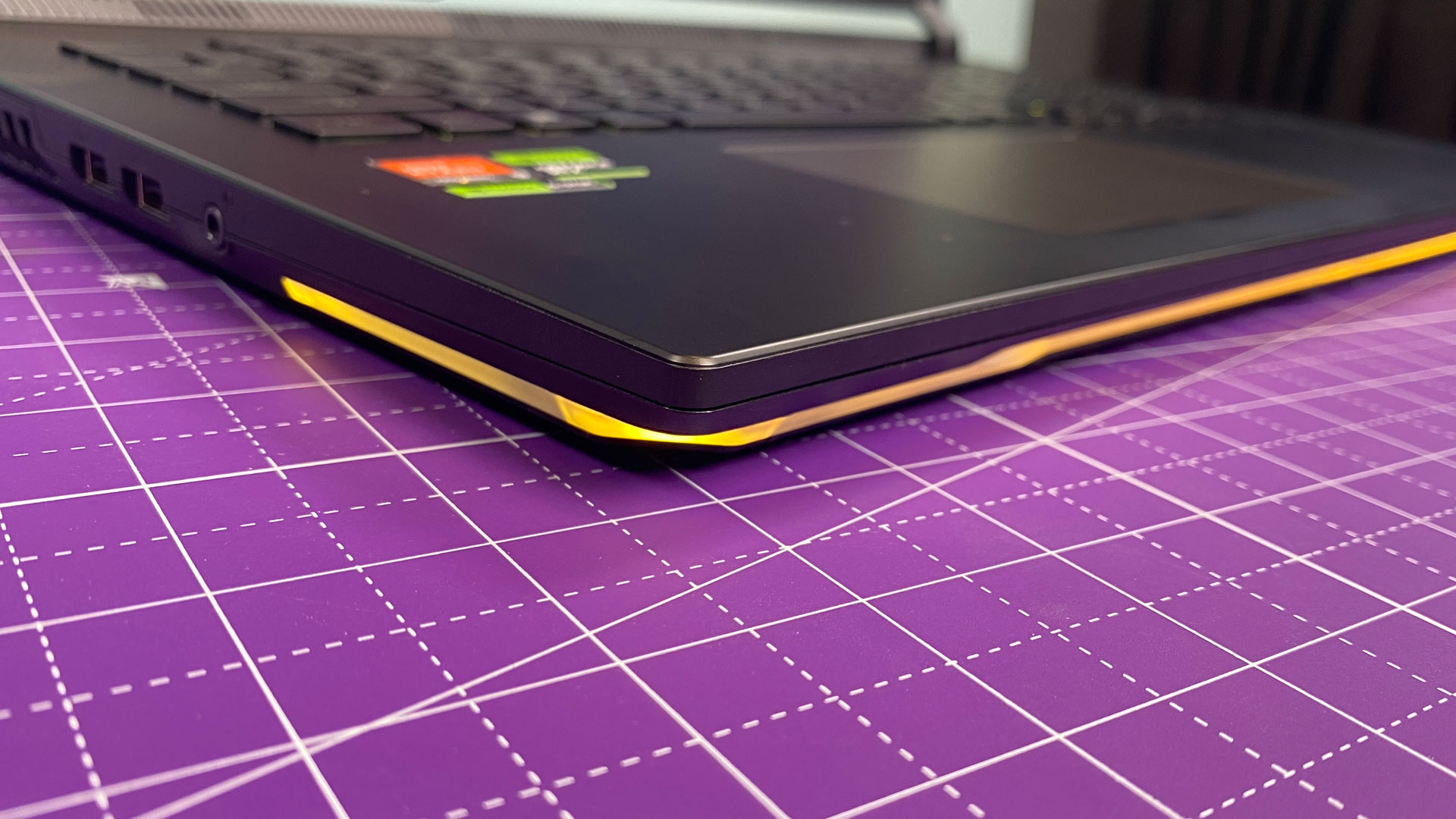
The deck is a soft-touch plastic, which feels nice enough against the wrists. On the 18-inch model, there was a change in the opacity, while it’s entirely solid on the new Scar 17. There is some flare on a few light bars mounted underneath the wrist rest. Those, along with the RGB keyboard, can be customized in Armoury Crate or Aura sync to make the laptop stand out.
Asus has kept the ports to two sides: the left and the back, leaving the right free for mouse movement. The left side has a pair of USB Type-A ports and the 3.5 mm headphone jack, while the back houses Ethernet, HDMI, and a pair of USB Type-C ports.
The Scar 17 X3D measures 6.61 pounds and is 15.55 x 11.10 x 1.11 inches. It’s smaller and lighter than many of the 17- and 18-inch laptops powering Intel chips and RTX 4090’s (though the 18-inchers do have a bigger footprint). The Asus ROG Strix Scar 18 is 6.83 pounds and 15.7 x 11.57 x 1.21 inches, while the Alienware m18 is a whopping 8.9 pounds and 15.71 x 11.57 x 1.21 inches. The MSI Titan GT77 HX is 7.28 pounds and 15.63 x 12.99 x 0.91 inches.
Asus ROG Strix Scar 17 X3D Specifications
| CPU | AMD Ryzen 9 7945HX3D |
| Graphics | Nvidia Geforce RTX 4090 (16GB GDDR6, 175W max graphics power, 2,040 MHz boost clock) |
| Memory | 32GB DDR5-4800 |
| Storage | 1TB PCIe NVMe SSD |
| Display | 17.3-inch, 2560 x 1440, 240 Hz, IPS, Anti-glare, G-Sync |
| Networking | MediaTek Wi-Fi 6E MT7922 (RZ616), Bluetooth 5.3 |
| Ports | 2x USB 3.2 Gen 1 Type-A, 3.5 mm headphone jack, 2x USB 3.2 Gen 2 Type-C, HDMI 2.1, Ethernet |
| Camera | 720p |
| Battery | 90 WHr |
| Power Adapter | 330 W |
| Operating System | Windows 11 Pro |
| Dimensions (WxDxH) | 15.55 x 11.10 x 1.11 inches / 395 x 282 x 28.3 mm |
| Weight | 6.61 pounds / 3 kg |
| Price (as configured) | $3,599 |
Meet the AMD Ryzen 9 7945HX3D
The Asus ROG Strix Scar 17 X3D is the first (and at the moment, only) laptop to house the AMD Ryzen 9 7945HX3D processor. This 16-core, 32-thread CPU is AMD’s first laptop to use 3D V-Cache, which powers the company’s high-end desktop processors.
This chip has a boost clock of up to 5.4 GHz (with a 2.3 GHz base clock), with a configurable TDP between 55 and 75W. With 3D V-Cache, it has 144MB of cache tota, including a 128MB L3 cache. AMD applies 64MB of L3 cache to the CCD to reduce requests to system memory, saving precious milliseconds to keep framerates high by reducing the time it takes to complete instructions.
This is AMD’s sixth chip using 3D V-Cache. Its predecessors are all desktop processors, including the Ryzen 7 5800X3D, the Micro Center-exclusive Ryzen 5 5600X3D, Ryzen 9 7950X3D, 7900 X3D, and Ryzen 7 7800X3D.
Gaming and Graphics on the Asus ROG Strix Scar 17 X3D
The Asus ROG Strix Scar 17 X3D comes armed to the teeth with AMD’s most powerful mobile gaming processor, the Ryzen 9 7945HX3D alongside Nvidia’s strongest gaming GPU for laptops, the GeForce RTX 4090.
I played Control, a favorite of mine, to take the Strix Scar 17 through its paces. At 2560 x 1440 with DLSS on, and high graphics and ray tracing presets, the game ran between 111 – 121 fps in a battle to cleanse a control point in the Oldest House’ maintenance sector.
We compared the Strix Scar 17 X3D to a trio of Intel-based system, the Asus ROG Strix Scar 18, the MSI Titan GT77 HX, and Alienware m18. All of those also use the RTX 4090. The Scar 18 and Alienware m18 both use the Intel Core i9-13980HX, while the Titan boasts a Core i9-13950HX. While we tested all of these systems at 1080p, their native resolutions are, well, all over the place.
Across the entire suite, the Asus ROG Strix Scar 17 X3D and AMD’s new chip showed significant improvements over the Ryzen 9 7945HX in the Asus Zephyrus Duo 16 in 1080p. While it’s tough to compare the resolutions directly, the Scar also had far superior 1440p performance to the 1600p native resolution on the Duo.
On Shadow of the Tomb Raider (highest settings), the Scar 17 had the second highest score at 1080p, at 188 fps. The Alienware m18 beat it if by just a few frames at 192 fps — in real gameplay, that may be within the margin of error. At its native 1440p the Scar hit 131 fps.
There was a similar pattern in Grand Theft Auto V, in which the Scar 17 X3D was just two frames behind the Alienware (179 fps compared to 181 fps) on very high settings at 1080p. The Titan was three frames behind the Scar 17. At 1440p, the Scar played the game at 121 fps.
The Scar 17 X3D strutted its stuff on Far Cry 6 (ultra settings) hitting 132 fps at 1080p, the highest of the group, and reaching 120 fps at 1440p.
Red Dead Redemption 2 at medium settings was perhaps the tightest race, with the Scar 17 at 129 fps at 1080p (90 fps at 1440p). That FHD number was slightly ahead of the Intel-based Asus and MSI machines, but not the Alienware (135 fps at 1080p).
On Borderlands 3’s “badass preset” the Scar 17 hit 172 fps at 1080p and 121 fps at 1440p. Both the Alienware and MSI outperformed at FHD here.
We stress tested the system by running Metro Exodus at RTX settings for 15 runs. The game averaged 98.46 fps on the hardware across the runs. The CPU cores ran at an average of 3.09 GHz and measured 82.18 degrees Celsius. The GPU ran 69.55 degrees Celsius.
Productivity Performance on the Asus ROG Strix Scar 17 X3D
A system with AMD’s top mobile chip, 32GB of RAM and a 1TB SSD ought to be fast for productivity, too. No surprises here, it is, though it traded blows in benchmarks with Intel-based systems, showing mixed performance in comparison. On desktops, the X3D chips were known for being better for gaming workloads than productivity, partially because it keeps the data close to the processing cores in the V-Cache, which is helpful for latency-sensitive applications like games, but not as much for productivity work.
On Geekbench 5, a synthetic benchmark heavily based on the CPU, the Scar 17 X3D with the Ryzen 9 7945HX3D achieved a single-core score of 2,139 and a multi-core score of 19,543. This isn’t a huge change from the Ryzen 9 7945HX in the Zephyrus Duo 16 (2,117 single-core, 19,446 multi-core).
In single-core, the Alienware m18 (with an Intel Core i9-13980HX) was the only competitor to beat the Scar with a score of 2,800. In multi-core, the MSI Titan GT77HX with its Core i9-13950HX hit 20,602. The Asus ROG Strix Scar 18, with the same chip as the Alienware, came close to the 17-inch X3D, but didn’t beat it.
On our file transfer test, the Scar 17 X3D copied 25GB of files at a rate of 1,416.52 MBps, falling just behind the Alienware m18 at 1,531.53 MBps. The rest of the field was faster.
On Handbrake, the Strix Scar 17 X3D fell a bit behind the field, transcoding a 4K video to 1080p in 2 minutes and 56 seconds. The Scar 18 took 2:49, and the Titan and Alienware were both even faster. In this test, the non-X3D Ryxen 9 7945HX in the Zephyrus Duo was actually faster (2:50).
Display on the Asus ROG Strix Scar 17 X3D
While we’ve seen many flagship gaming laptops move to taller, 16:10 displays this year, the Asus ROG Strix Scar 17 X3D has stuck with a traditional 16:9 panel. It’s still large at 17.3-inches diagonally and boasts a 2560 x 1440 resolution, 240 Hz refresh rate, G-Sync, and support for Dolby Vision HDR.
I appreciated the anti-glare coating. It let me play games even near a bright window in my apartment. It also helped when I watched the trailer for The Marvels, showcasing vivid reds in Kamala Khan’s scarf and costume as well as some bright greenery on an island. But a lot of this trailer takes place in space, and I would like to see some deeper blacks.
When I played Control, I saw a similar pattern. The game’s reds (there’s a lot of red in that game), from damage I took to various carpets in the Oldest House, really popped. Other colors looked fine, but didn’t stand out in any fashion.
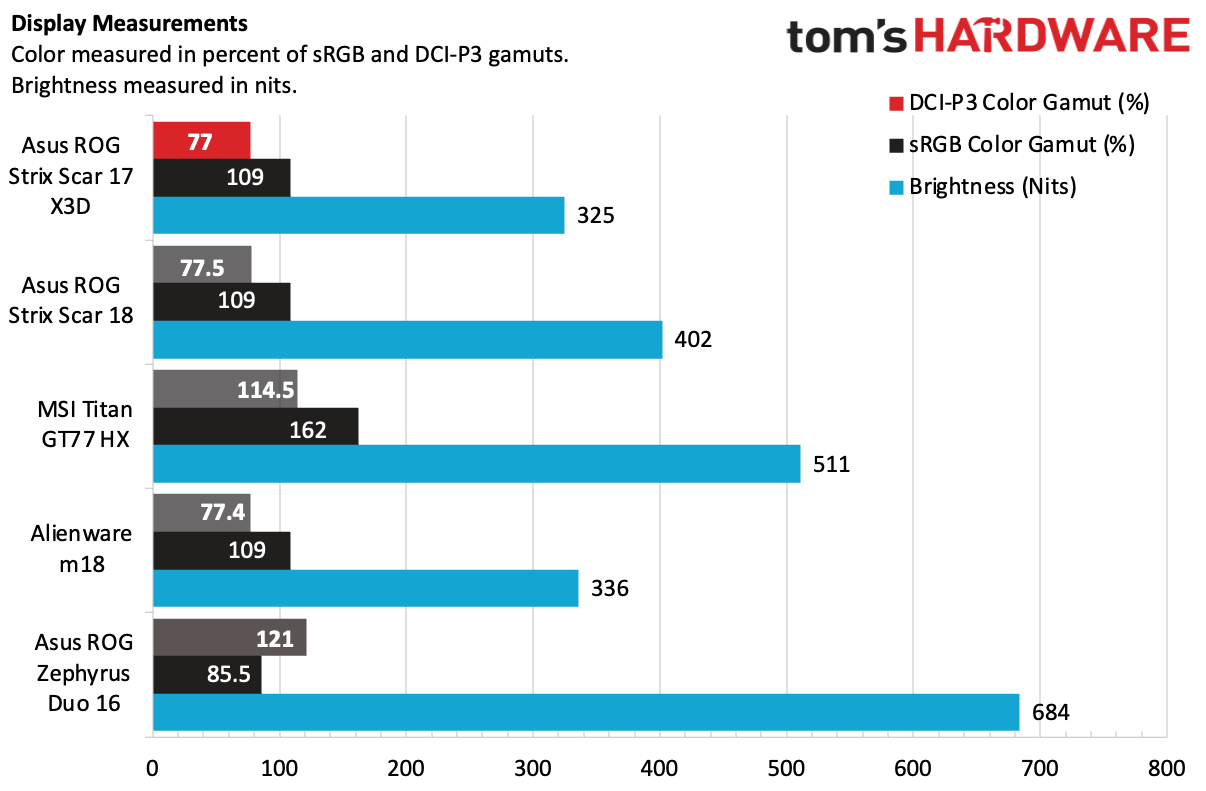
According to our colorimeter testing, the Strix Scar 17 X3D covers similar swaths of the color gamut as the Strix Scar 18, at 77% DCI-P3 and 109% sRGB (the Alienware m18 was also remarkably similar). But the MSI Titan GT77 HX and Zephyrus Duo 16, with mini-LED panels, is far more vivid.
Unfortunately, the Strix Scar 17 X3D’s screen isn’t as bright as the Strix Scar 18. Our test subject measured 325 nits on our light meter, while its bigger sibling hit 402 nits. The Zephyrus Duo 16 was the brightest, at 684 nits.
Keyboard and Touchpad on the Asus ROG Strix Scar 17 X3D
Asus’s keyboard is fine. I’d like more clicky feedback (Alienware and MSI have included low-profile mechanical keys on some of their high-end gaming laptops to great effect), but these do well enough. On the monkeytype.com typing test, I reached 109 words per minute with a 98% accuracy rate.
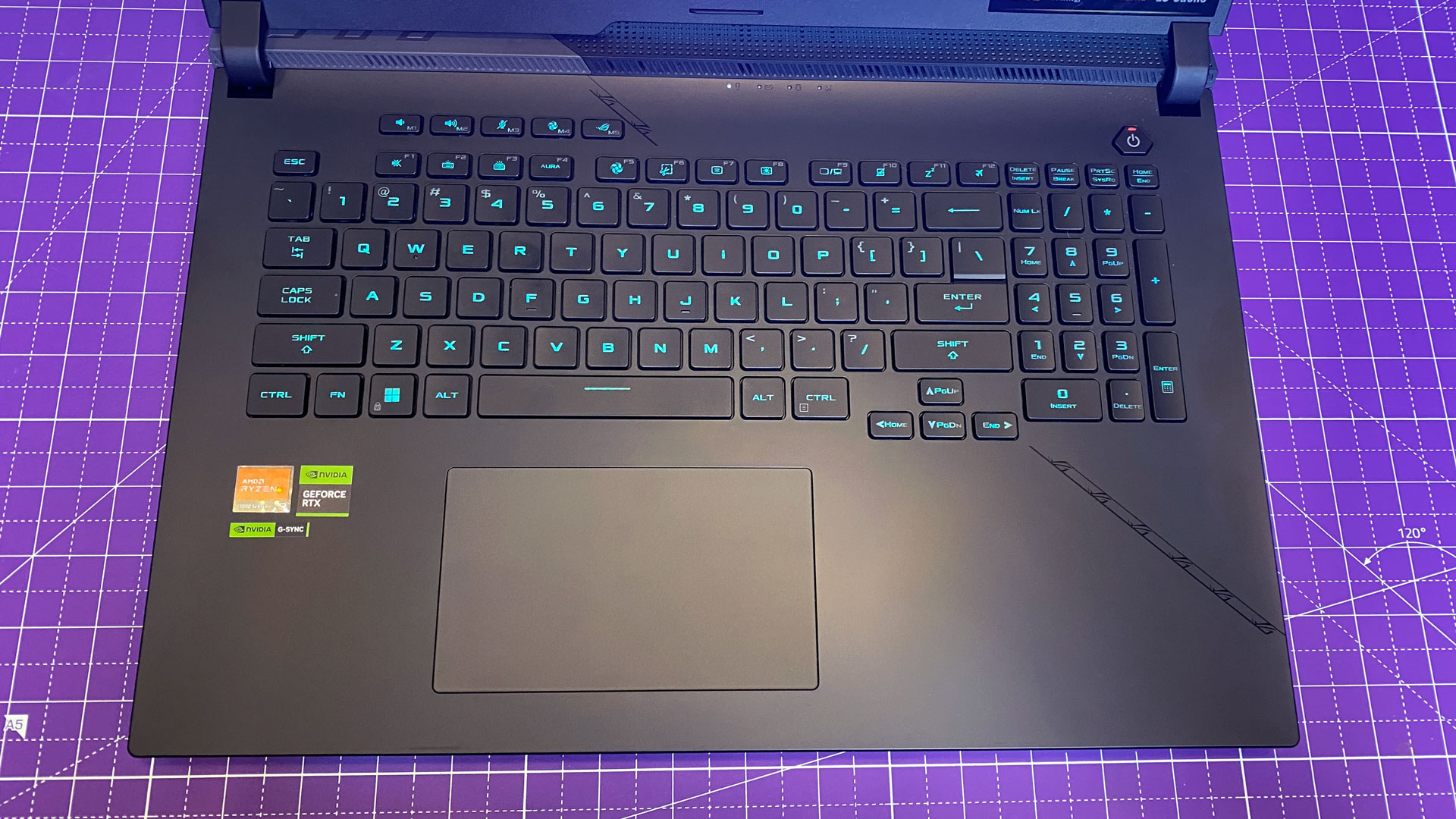
This keyboard actually has a better layout than Asus’ 18-incher, which crammed in the arrow keys and shortened the right shift key. Here, while the arrow keys are unfortunately half-sized, everything else feels normal.
While I don’t see many people using the touchpad in games, it’s still important if you’re working on the laptop. The touchpad is sizable, but doesn’t take up the whole deck. There’s a little friction when dragging my fingers, but it responds well to gestures in Windows 11.
Audio on the Asus ROG Strix Scar 17 X3D
The Strix Scar 17 boasts a dual-speaker system with support for Dolby Atmos.
While listening to music as I wrote this review, Paramore’s “This Is Why” filled my living room with sound, though I expected something a bit more booming out of a 17-inch notebook. Still, it offered clear vocals and guitars, and even a bit of a bass in the verses (though it drowned in the chorus).
The Dolby Access app let me make some Atmos tweaks. The “detailed” setting brought out a bit more of the drums, but also focused more on the vocals than the more measured default “balanced” mode. If volume is what you’re looking for, switching to Dynamic, movie or game mode all boosted the loudness significantly.
The speakers were better for gaming than music. In Control, each shot from Jesse’s service weapon had a resounding boom, and her internal monologue came through clear. Some of the haunting music was a bit quiet, but it still added an eerie background to the game.
Upgradeability of the Asus ROG Strix Scar 17 X3D
To get into the Asus ROG Strix Scar 17 X3D, you’ll need to loosen or remove 11 Phillips head screws. Three of them, along the edge of the wrist rest, are shorter than the rest, and the one on the bottom right-hand corner is captive. Be sure to keep the different lengths separate and remember where they go.
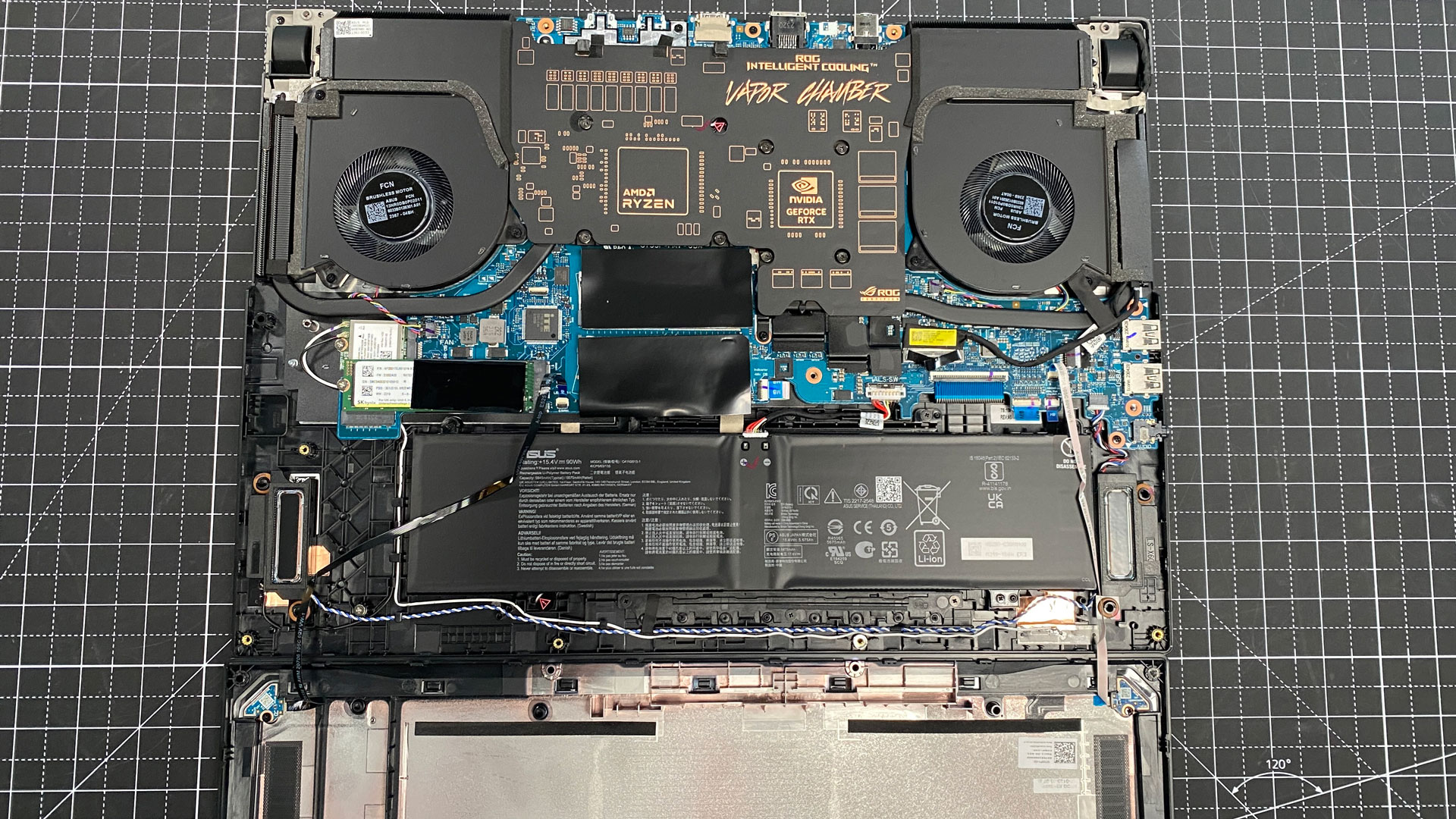
From there, you need patience and a spudging tool to slowly work around the gap created by the captive screw. This took me a few minutes (and a bit of cursing), but I eventually lifted the base off. Be very careful here, though: There are two ribbon cables attached to the bottom casing and the motherboard that control the RGB lighting. You wouldn’t want to break these by lifting the base too quickly. One of ours disconnected, which involved me removing the RGB module from the base with a screwdriver before delicately replacing it.
Once you’re in, you have access to the battery, two RAM slots (both were filled), the SSD and the Wi-Fi card. I’d like to see another SSD slot on a laptop this size, but Asus spent most of the space on a massive cooler and vapor chamber for the CPU and GPU.
Battery Life on the Asus ROG Strix Scar 17 X3D
Monstrous gaming laptops rarely last long on a charge. In our testing, the Strix Scar 17 X3D had the shortest battery life among its competitors. On our test, which browses the web, streams videos, and runs OpenGL tests with the display set to 150 nits, the Scar 17 X3D ran for 3 hours and 36 minutes. The next shortest, the MSI Titan, lasted 3:48, while the rest of the field hovered around four and a half hours.

Heat on the Asus ROG Strix Scar 17 X3D
To measure surface temperatures on the Strix Scar 17 X3D, we a Flir thermal camera while running our Metro Exodus stress test.
At the center of the keyboard, between the G and H keys, the Scar measured 41.6 degrees Celsius (106.88 degrees Fahrenheit). This is a bit warm, but notably, our thermal imaging camera caught that the cooling system managed to keep the hottest portions around the keyboard.
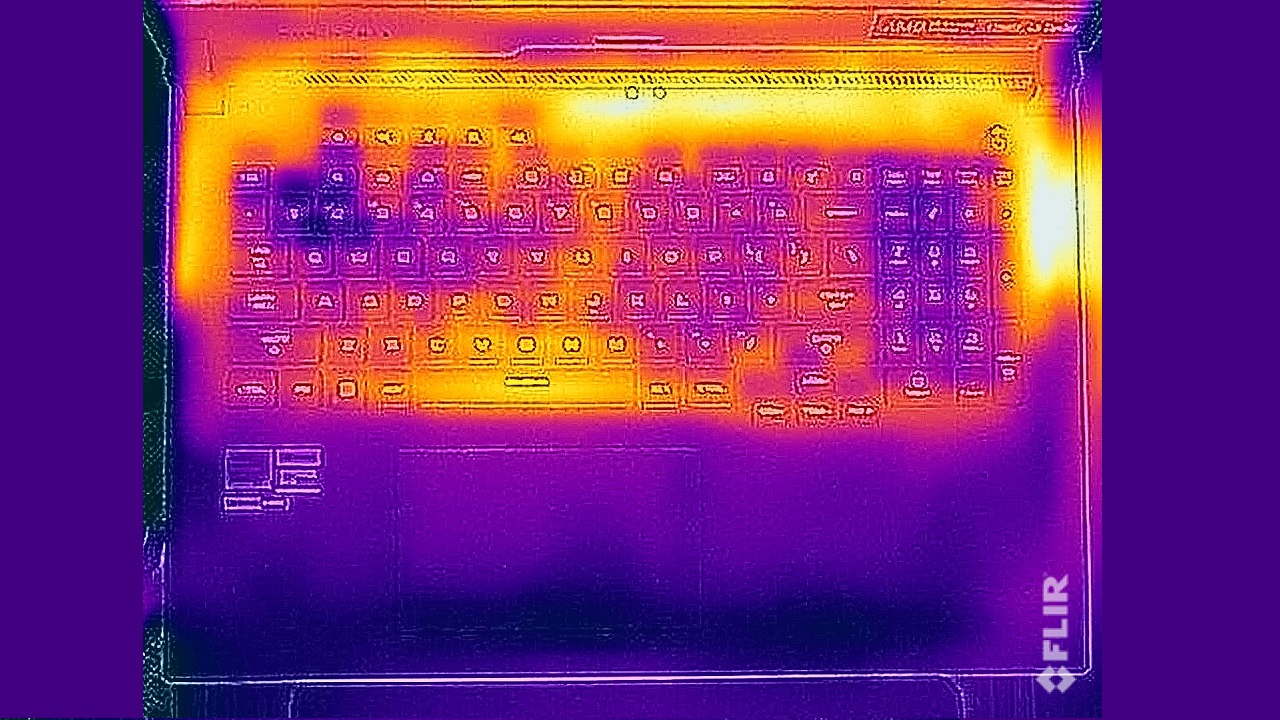
Meanwhile, on the bottom of the system, the hottest point measured 56.6 degrees Celsius (133.88 F). Keep this one on your desk.
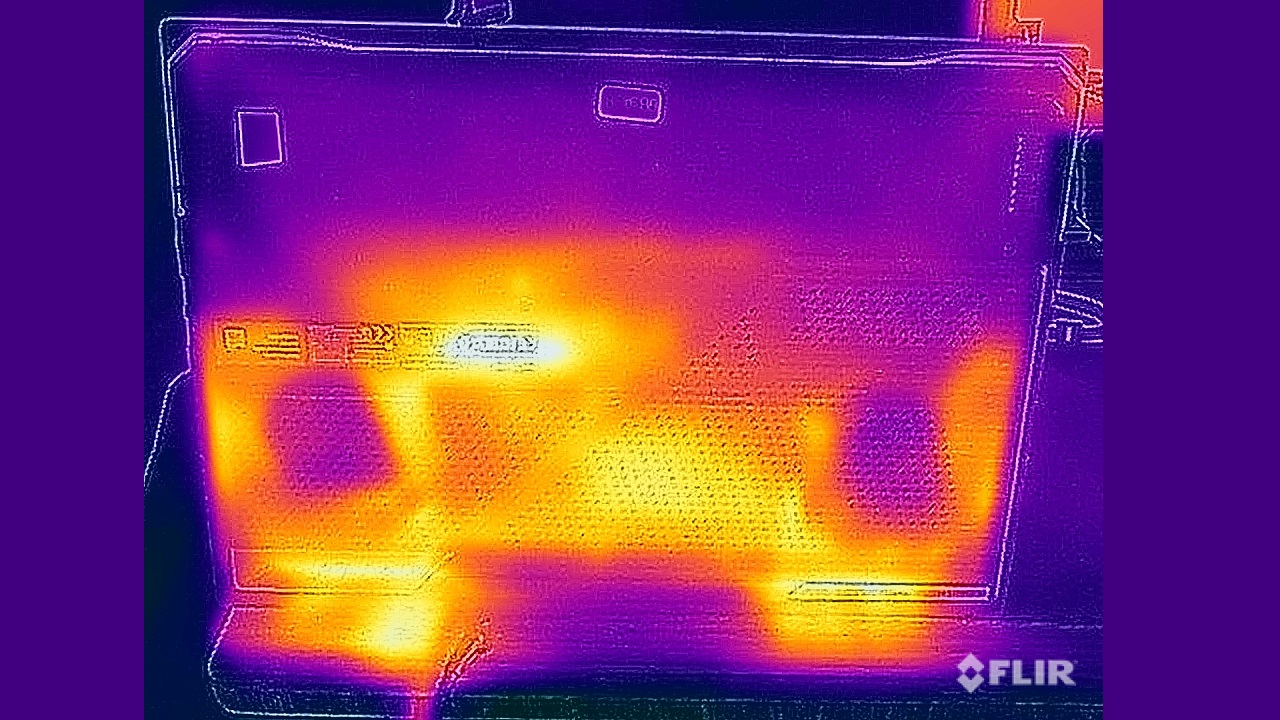
Webcam on the Asus ROG Strix Scar 17 X3D
I’m sorry, but it’s 2023, and the Strix Scar 17 X3D is a premium product; it should have a 1080p webcam. Some people might want to use this for streaming! (If that’s advisable is a question, but they may want to!).
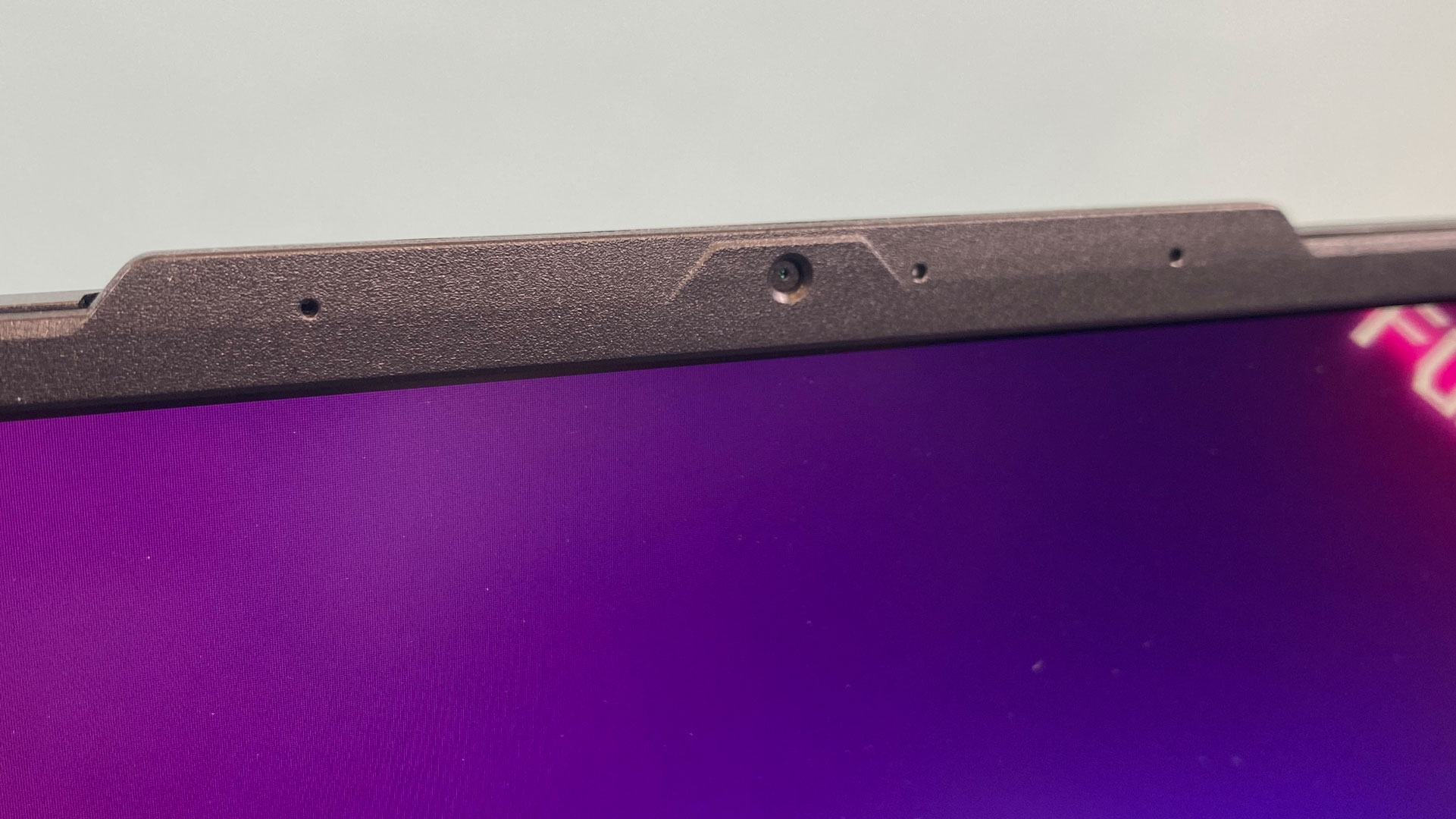
Unfortunately, this one is still at 720p, like we’re still in 2018. Resolution doesn’t always affect quality, but the sensor here is just OK. While colors, like an olive green shirt I was wearing, were close to accurate, there was still some smudging, especially in my hair, and light in windows near and far were totally blown out.
Software and Warranty on the Asus ROG Strix Scar 17 X3D
Asus crams a fair bit of software on the Strix Scar 17. There are some you may want to use, like Armoury Crate, a one-stop shop for usage statistics, performance modes, RGB lighting, game profiles and more, and a separate app called Aura Sync with even more advanced lighting options.
But Asus also packs in GlideX, a cross-platform screen sharing solution that ultimately requires a subscription for full use. There’s also MyAsus to manage warranties and get product offers. Asus packs in a fairly useless Virtual Pet, which can’t do anything other than walk around your screen and get mad when you click on it. There’s also a trial of McAfee LiveSafe.
The Windows Start menu comes with its fair share of links to the Microsoft Store, including Spotify, WhatsApp, Amazon Prime Video, Netflix, Instagram, and Facebook Messenger.
Asus will sell the ROG Strix Scar 17 X3D with a one-year warranty.
Asus ROG Strix Scar 17 X3D Configurations
We tested a $3,599 configuration of the Asus ROG Strix Scar, with the AMD Ryzen 9 7945HX3D, Nvidia GeForce RTX 4090, 32GB of DDR5 memory, a 1TB SSD, and a 17.3-inch, 1440p display.
AMD tells us Asus will have a second version with a 2TB SSD, but otherwise identical specifications, for $3,699.
Bottom Line
If you want the most powerful gaming CPU that AMD offers in a laptop and have at least $3,599 to burn, the Asus ROG Strix Scar 17 X3D is your one and only choice – since for now at least, this CPU is an exclusive in this laptop. For that amount of money, you get strong gaming performance, bringing AMD up to par with Intel in our gaming suite.
What I’d really like to see here is additional features that befit a flagship CPU, including a better screen (Iike the mini-LED displays in the Ryzen-based Zephyrus Duo or the Intel-based MSI Titan), and definitely a webcam from this decade.
That being said, the Zephyus Duo is even more expensive with that display ($3,999.99 as tested), and the Scar 17 X3D is in line with the pricing on the Intel-based Scar 18. We tested an Alienware m18 R1 for a similar price, but it trades off the higher-res screen for more RAM.
If you have the cash for a strong gaming PC and want an AMD chip no question, the Strix Scar 17 X3D is both your best (and only) option. Hopefully next year Asus will spiff the system up a bit.
MORE: How to Buy a Gaming Laptop
MORE: Best Gaming PCs
MORE: Best Ultrabooks and Premium Laptops














